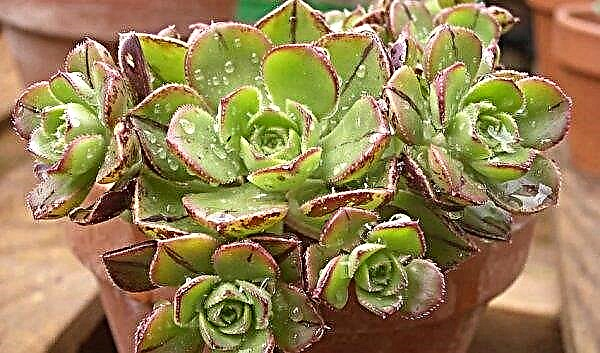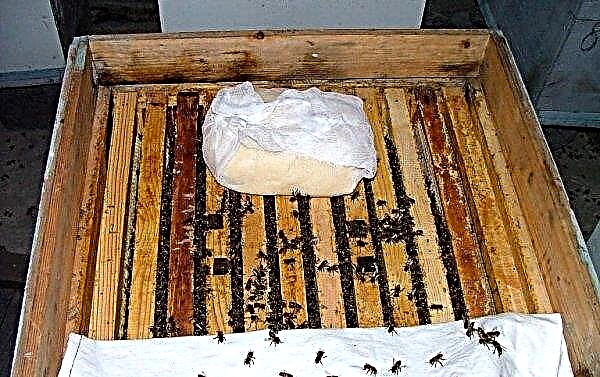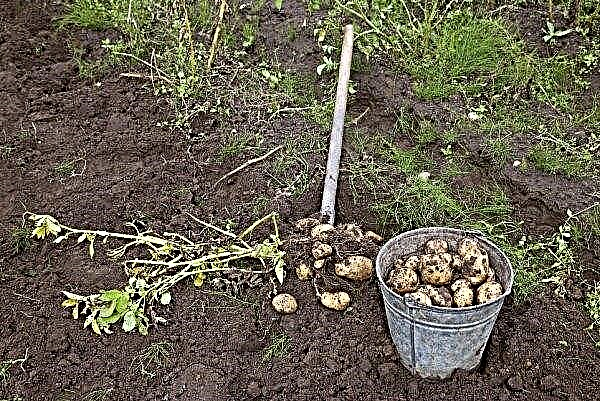The rock garden in modern landscape design takes one of the most honorable places. A garden made in this style always has an incredibly beautiful composition, while at the same time giving an atmosphere of comfort and tranquility. The article describes in detail what an Alpine hill is, a description of the main rules for its creation, as well as step-by-step instructions for design.
What is a rock garden in landscape design
The so-called rock garden or alpine hill is a landscape composition that repeats the landscapes of the mountains. Its center is one or more hills created from garden soil, as well as all kinds of large stones or boulders. In this case, the entire site is divided into several zones imitating the foot of the mountains, the middle tier, etc.
There are two varieties of rock gardens - natural and artificial. The first is often called classical, it is aimed at copying the landscape and flora of a certain geographical area as accurately as possible. The second is distinguished by the fact that atypical flora can be planted near artificial rocks, including perennial and annual flowers. In this case, the summer cottage or a separate flowerbed is called rockery.
This design can be made in the form of:
- terraces;
- cliffs;
- gorges;
- slope;
- plateau;
- cliffs;
- mountain valley.
In most cases, the alpine hill is the central object, according to which other garden areas are stylized. However, it is permissible to incorporate it into the finished composition, while it must necessarily be harmoniously combined not only with the terrain, but also with the surrounding flora.
Video: Recommendations for placing a rock garden in the garden
What plants and stones can be made
To create a real mountain landscape on the site, various types and varieties of plants are used that maximally satisfy personal aesthetic needs, therefore, often all kinds of spicy herbs are used for its design (basil, thyme, parsley, oregano, leek, etc.). However, there are so-called traditional plant groups, without which it is almost impossible to imagine an alpine hill.
Did you know? Japan is considered to be the birthplace of the alpine hill; on the territory of the country, summer cottages in this style have been decorated since ancient times. Rock gardens in Europe first appeared in the 16th century, with a peak in popularity and development in the 18th century.
These include, first of all:
- conifers - all sorts of undersized trees or shrubs look most harmoniously, which are the basis of the whole composition (for example, thuja, mountain pine, juniper);

- creeping forms - the most profitable option is considered to be creeping varieties of shrubs and herbaceous species, characterized by bright foliage or flowers (for example, saxifrage, sheath, juniper, Iberis);

- grassy species - it is best to pay attention to perennial plants traditional for mountainous areas (for example, edelweiss, juvenile, alissum). In addition, the rock garden should be decorated with all kinds of bulbous, brightly blooming forms (for example, crocuses, snowdrops).

Did you know? The oldest existing garden in the world today is considered to be Levens Hall (Great Britain). It was created back in the XVII century by the famous landscape designer Guillaume Beaumont.
Most often, the mountain landscape is recreated with the help of such stones:
- granite - dense stone, characterized by minimal water absorption. It can be all kinds of dark shades of green, black, gray and red. In most cases, large boulders made of granite look most beneficial, they give flowering plants a special sophistication and tenderness;

- sandstone - is the most popular option, as it is combined with almost any representative of the flora. This is a fairly smooth coarse-grained rock with enhanced decorative properties. The stone is also distinguished by a rather rich color scheme, represented by all kinds of combinations of beige, brown, brown-pink, brown-red;
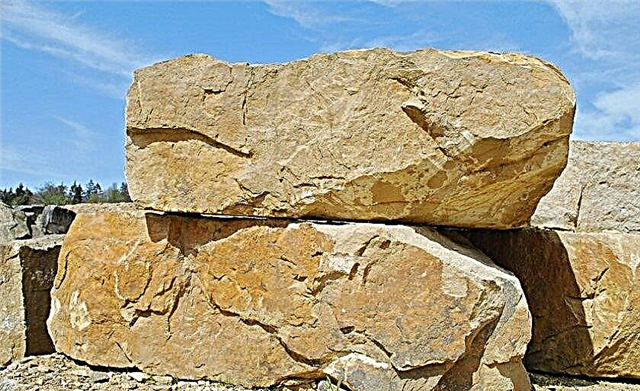
- limestone - the softest stone, characterized by increased vapor permeability and moisture capacity. It is easily processed, which makes it possible to create almost any garden project. The color scheme of the stone is also rich, there are all kinds of shades of brown, gray, beige and black, with admixtures of blue, pink, golden tones. The most popular varieties of limestone are dolomite and tuff.
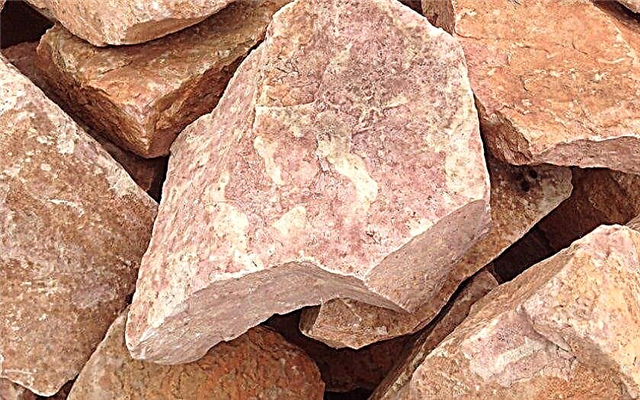
DIY step-by-step instructions
The construction of a rock garden is a simple, but requiring patience and attention procedure. It provides for the mandatory preparation of the site and soil, as well as the implementation of all actions in a certain order. They begin to build the structure in the second half of autumn, as it shrinks in the ground for 3-4 months.
Alpine Hill Plan
The construction of a rock garden is a real creative work that allows you to create a garden according to individual requirements and characteristics. However, professional designers distinguish several typical patterns that allow you to enter rough stones in any relief.
Among them, the most popular are:
- rock - a hill of a pyramidal structure with steep slopes. Its basis is large boulders, half immersed in the substrate. Smaller stones are arranged around the main in several cascades, up to the base. Plants are planted at the foot and on each cascade of slopes;
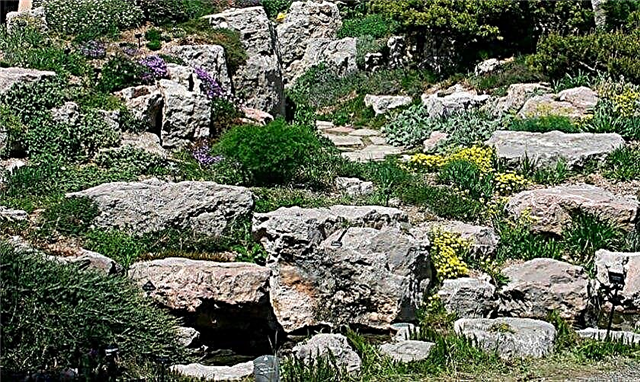
- scree - design with one steep slope. Its base is made up of crayons and middle stones at the foot, while larger ones are located at the top. All kinds of plants are planted around the perimeter of the entire slope;

- valley - the simplest composition, consisting of randomly located boulders, medium and small stones. The entire territory of the flowerbed can be located both on the plain and on a small hill;

- slope with terraces - looks like a small hill, divided into several gentle cascades. The whole structure at the same time takes a step structure, plants are planted in small groups on each tier;

- ravine - Looks as profitable as possible in the lowlands. The ravine is a low bed with a central depression. Large stones are placed on the sides of the ravine, small and medium are closer to the center, plants are planted randomly;

- wall - It is a low perpendicular wall or border, made of flat stones. Flowering species are planted at the top, conifers and creeping plants are at the base;

- waterfall - rock garden is performed in the form of several stony cascades of flat stones. At the base of the structure, there is a small reservoir in which water should gradually drain from the top. All kinds of vegetation are planted around the perimeter of the water flow, while exclusively hygrophilous species are recommended for planting.

Place selection
When choosing a place for a flowerbed, it should be taken into account that it, first of all, should become the center of the garden, therefore they only have it in open and well-viewed areas. The center or one of the edges of the plot is best suited for this, while the mountain landscape in areas with natural hills and elevations looks the most advantageous.
It is also important to take into account the fact that the flowerbed should be well lit. For this, places in the south or south-west direction are best suited. It is not recommended to break the alpine hill near various garden buildings, as well as tree-like vegetation. In this case, it is allowed to use trees and shrubs at a distance, to create the necessary background.
Important! Alpine slide must be well lit. This is especially important if flowering plants play a major role in its decoration.
Sod removal
Sod is usually understood as the top layer of soil penetrated by a dense network of forbs. Its removal before the arrangement of the rock garden must be done, otherwise it will not work to create a solid foundation for the flowerbed. In addition, turf is a source of all kinds of weeds, which often lead to the death of decorative flora.
To remove the turf, it is enough to remove the top layer of 15–20 cm from the soil, do this with a shovel or other garden tool. The withdrawn substrate must be removed from the site, since in the future it is not used to create a flowerbed. After that, the entire perimeter must be aligned to one plane.
Foundation and soil preparation
All kinds of stones create increased pressure on the soil, so without special preparation, the rock garden, after a few years, will need to be updated. To avoid this, in place of the removed turf you need to make a recess of 30 cm, and then as the base you need to pour and crush crushed stone or pebbles well (10-15 cm layer).
As an alternative, you can use broken brick. On top, you must necessarily pour a layer of 5 cm of river sand. Such a pillow can withstand almost any structure, including one based on large boulders. 
Additionally, a substrate should be made for future plants. It is prepared from equal parts of garden soil, river sand and peat, while it is also possible to use ready-made mixtures from any garden store. Before filling the flowerbed, the substrate must be sterilized, for this it is soaked with 2% solution of copper sulfate.
Slide construction
The construction of the slide begins with a breakdown of the terrain and determination of height. During this, it is imperative to use the principle of a harmonious relationship between the height and width of the flower bed: for every 20-30 cm of an artificial hill, the diameter of the flower bed should increase by about 1 m. At the same time, rock gardens with a height of about 0.5-1.5 m look most aesthetically pleasing.
Carry out this procedure as follows:
- Level the area under the future flower bed to the level of the entire site with the help of specially prepared soil, and then compact it well.
- Deepen large or medium-sized stones throughout the entire territory by about half. Fill all the gaps between the stones with prepared soil, and then water it well.
- After the soil settles and the water is absorbed, add soil to the required level.
- Form the required number of tiers and the shape of the flowerbed according to the principle described in the previous steps. At the same time, small pockets with soil should be formed between the stones on the outside.
- Water the slide well and leave it alone until the next season.

Planting plants
After wintering, the alpine hill becomes completely ready for planting plants. Landing is carried out in previously formed pockets with soil on each tier according to a certain pattern. Shrubs and tree plants are the first to plant, they should become the basis for which any other ornamental plant should be planted.
Important! Zealous with the species diversity of the flora is not worth it. Plants are only an addition, but the main role is played exclusively by stones.
The center and upper zones of the flower bed are best suited for this. After that, various shrubs are planted, followed by grassy species and flowers (in the middle tier). Ground cover plants are placed last at the base, which should harmoniously complement tall plants.

Finishing touches
The final stage in the creation of the rock garden is the construction of the transition zone between the rocky landscape and the main relief. To do this, make a mound of fine gravel around the hill or lay out a small curb from the stone, however, it is permissible to surround the flowerbed and moss.
Also, to complete the creation of the composition, various decorative elements, as well as garden furniture, are installed. If a whole complex is created on the site, in conclusion, a narrow and winding paved path should be created between the slides. It is further recommended to create a contrast for the alpine hill, for this a lawn should be planted around it. This solution will allow you to most effectively allocate a flowerbed and give it a special decorative effect.
It is further recommended to create a contrast for the alpine hill, for this a lawn should be planted around it. This solution will allow you to most effectively allocate a flowerbed and give it a special decorative effect.
A rock garden is the best solution for any garden. It allows you to realize almost any idea, as well as create a sophisticated and sophisticated composition. It is not difficult to equip it on the site, however, this will require a subtle sense of proportion and aesthetics, as well as at least minimal design skills. Otherwise, it will be impossible to achieve the desired effect from the mountain landscape.















